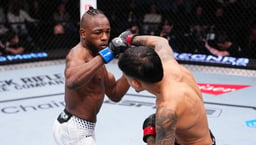
Issue 138
February 2016
Conor McGregor has reached a new level of intellectual and creative ability in the Octagon
Genius. Complex to define in fight sports, but Conor McGregor clearly has it. But it has taken studious steps in training and preparation and a champion’s desire to step outside the box. Beyond McGregor’s mental warfare – which is off the charts – there is the confidence in what he calls “the sequences” in his head. They have elevated the Irishman to a new plane in erudition with victory over José Aldo. His genius was right to the fore in those 13 seconds of greatness in Las Vegas in December.
Every great champion seeks the scintilla of an advantage to stay on an upward curve. Fight sport is littered with such actions. Greg Jackson made a young Jon Jones study The Art of War by Chinese military general Sun Tzu, to instill in him the mores of winning mental warfare at every turn.
Fight sport history is replete with acts of genius and – it has to be said – its fair share of bunkum theories, too. But when they work, they really can win the most important contest of a fighter’s career, and even define them.
Tommy Loughran, a boxer from 1919-37, was a past-master of the sweet science, using evasive techniques and even timing each round in his head so that he would end up in his own corner at the end of each stanza, with his team’s words ringing in his opponent’s ears. James J Corbett would ask his opponent, as they faced off with the referee: “Any excuses tonight?”
There have been myriad ‘tricks’ of genius in boxing. Archie Moore would turn up for weigh-ins in a full-length tux, talking to his opponent in cliches, confusing them. Kid McCoy – the inspiration for The Real McCoy, by the way – was the inventor of the corkscrew punch, which when twisted, could tear an opponent open.
Willie Pep stepped on opponent Sandy Saddler’s toes in their rematch. Joe Gans used the ring like a laboratory, studying his opponents’ style and then implementing his findings to win emphatically, like when he knocked Frank Erne out 100 seconds into their fight. So McGregor with Aldo – simple, sequenced, but also bearing the hallmarks of genius. McGregor knew Aldo’s right hand was long and telegraphed, and moved himself into the space between them to unload that devastating short left hand.
Fascination with movement will now define McGregor, whose chest-beating rise has been replaced by a Zen-like adherence to movement and focus in the fractions of a second which can make or break, win or lose, the greatest gambles a protagonist can take within contests.
There were many raised eyebrows when movement guru Ido Portal took McGregor through his paces at the UFC 194 workouts. There were methods we had never seen before. Not out of place, I felt, on a hillside monastery in Tibet, but in preparation for an Octagon fight?
It was a slow dance, McGregor sliding into limbo stretching around a wooden stick, which Portal shaped into space, as the now UFC featherweight champion elongated his limbs, torso and neck. It was mesmerizing. Bizarre, even. Yet it worked.
The self-proclaimed “movement artist” has even admitted since the victory that “as the new factor in the equation” around McGregor, he had prepared for blame to be placed on his shoulders had the Dubliner lost to the Brazilian. McGregor wanted to study movement, the thing he believes gives him the advantage with his incredible spatial awareness.
Credit also to SBG Ireland head coach John Kavanagh, who deserves great praise for the rise of a fighter and indeed an entire team, who have shifted the paradigm with a new touch of genius.
Five KOs in a row
McGregor became just the sixth fighter in UFC history to score five consecutive knockoouts.
...









